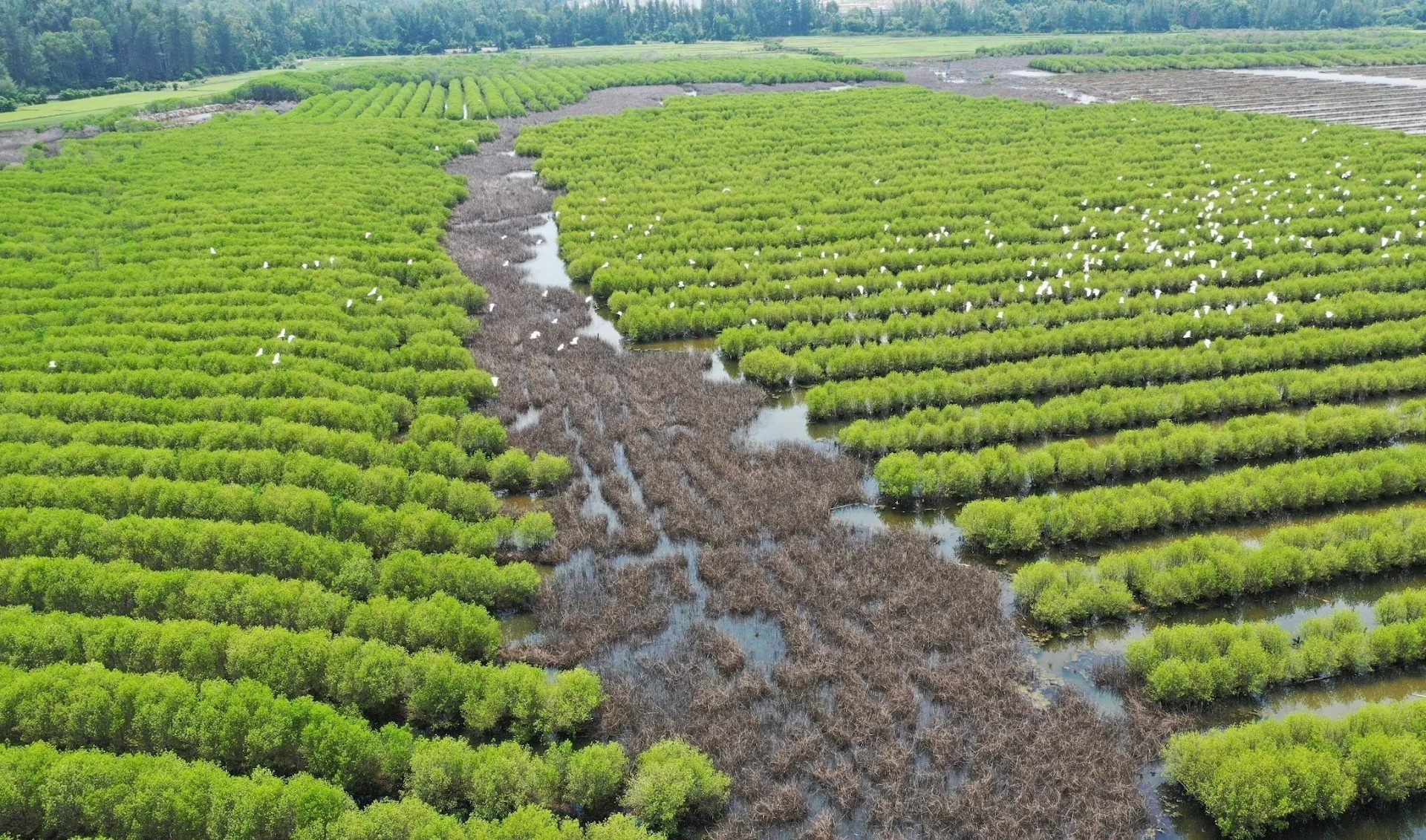The south-central provinces - Quang Ngai, Binh Dinh, Phu Yen, and Khanh Hoa - are on the front lines, bearing the brunt of climate change and disaster risks. In response to the Government’s directions, they have embarked on a concerted effort to restore mangrove forest belts, and the results are beginning to shine through.
Reviving mangrove forests
With over 800 kilometers of coastline, these localities are home to mangrove forests nestled in coastal lagoons, albeit in small patches.
 |
| The Bau Ca Cai mangrove forest in Quang Ngai province has been recovered since 2015. |
Economic pressure, particularly the rapid expansion of shrimp farming and infrastructure projects, has led to the destruction of much of these pristine mangrove forests and a rapid decline in their ecosystem.
This degradation has not only accelerated coastal erosion but also resulted in significant losses for local fisheries.
However, hope is on the horizon. Over the recent years, local residents, alongside various global and domestic organizations, have stayed united to restore these vital ecosystems. The once barren and desolate coastal lands are now being revitalized, with hundreds of hectares being reforested with mangroves.
Ho Trong Phuong, Director of the Quang Ngai Provincial Department of Agriculture and Rural Development, said from 2014 to 2021, the province launched three projects to plant, zone, and regenerate mangrove forests, with a total investment of about 33 billion VND (1.323 million USD). This initiative has successfully restored over 109 ha across Binh Thuan, Binh Tri, Binh Dong, and Binh Phuoc communes, featuring species such as ambarella, red mangrove, and nipa palm.
Binh Dinh has also been pro-active since 2003, now boasting nearly 90 ha of newly-planted mangrove forests, including the Con Chim ecological area in Phuoc Son commune, Tuy Phuoc district, and tidal flats along Thi Nai and De Gi lagoons.
Truong Xuan Dua, head of the Agricultural Technical Application Research Station at the Provincial Rural Development Centre, said these restored mangrove forests not only help prevent erosion but also restore ecosystems, preserve biodiversity, and create jobs for coastal residents, thereby contributing to both socioeconomic development and environmental protection.
Phu Yen is making strides as well, with a commitment to greening O Loan Lagoon through a project that aims to plant mangrove forests covering 50 ha at a cost of over 18 billion VND. The newly planted mangroves in An Hoa Hai, An Ninh Dong, and An Hiep communes will provide essential habitats for species such as mangrove apple, ambarella, red mangrove, and nipa palm.
Le Van Be, Deputy Director of the Phu Yen Provincial Department of Agriculture and Rural Development, noted that when the 50 ha of mangrove trees develop into a forest, they will provide a habitat for various fish species to shelter and spawn, enhance and restore biodiversity and preserve rare aquatic species in the O Loan Lagoon. Consequently, local residents around the lagoon will benefit from various replenished species, including aquaculture and fishing.
Developing unique tourism products
Quang Ngai province is already offering ecotourism experiences in the mangrove forests of Bau Ca Cai in Binh Thuan commune, Ca Ninh Nipa palm forest in Binh Phuoc commune, Binh Son district, and Tinh Khe Nipa palm forest in Tinh Khe commune, Quang Ngai city. Bau Ca Cai, in particular, has a distinctive ecosystem featuring the native white mangrove species. In spring, the landscape transforms into a lush green paradise, while late summer brings a breathtaking “snow-white” scenery as the trees shed their leaves, captivating visitors.
Director of the provincial Department of Culture, Sports and Tourism Dinh Tien Dung noted that beyond beach and island tourism, the province is keen on developing rural and agricultural community-based tourism as a key product for the future.
Each year, tens of thousands of tourists flock to the Bau Ca Cai mangrove forest, Ca Ninh and Tinh Khe Nipa palm forests. Going forward, Quang Ngai plans to improve infrastructure to officially recognize these ecosystems as official tourism sites or "One Commune, One Product" (OCOP) tourism spots, ensuring high service quality, added value, and sustainable livelihoods for local residents.
Binh Dinh’s Thi Nai lagoon, spanning 5,000 ha with over 1,000 ha covered by mangrove forests, is another ecological treasure with significant value. Its three notable islands - Con Chim, Con Trang and Con Gia – are collectively known as the Con Chim ecological area covering 480 ha. Locals affectionately call it the "Green Oasis" of Binh Dinh. Experts believe that if properly conserved and developed, it could become a "green lung."
In Khanh Hoa, the mangrove forest on Hoa Lan island in Ninh Phu commune, Ninh Hoa township, has also been tapped for ecotourism, providing substantial benefits for the community. This ancient primary forest is home to a diverse ecosystem, including rare flora and fauna such as mangrove, nipa palm, and various species of bird, fish, shrimp, and crab.
Since 2022, it has offered unique ecotourism experiences such as kayaking, trekking, and fishing, allowing visitors to learn about local life and immerse themselves in the unique mangrove ecosystem.
VNA





